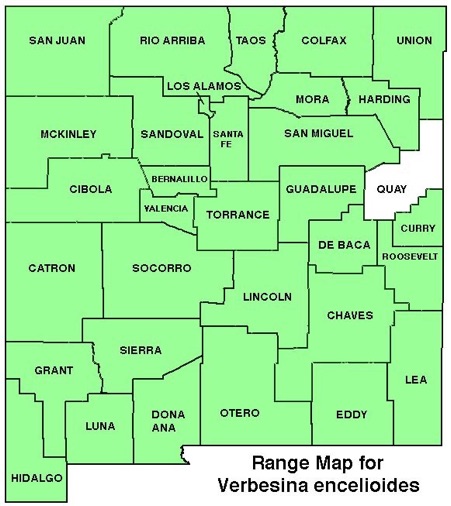WILDFLOWERS OF NEW MEXICO

Bushy, 1–3-feet tall and wide with stout stems and numerous large leaves, this robust plant is covered with gray-green hairs and thrives in disturbed soils. In wet years, it can cover old fields with a blanket of golden flowers. Note the large, triangular gray-green leaves with winged stems, and the narrow phyllaries that spread out beneath the rays.
FLOWER: April–October. Showy 3/4–1 1/4-inch wide (2–3 cm) flower heads bloom on long flower stems (peduncles). The 10–15 orange-yellow, petal-like rays, 1/2-inch long (12 mm), have 3 teeth on the tips and surround a yellow disk. Phyllaries narrowly lance-shaped, hairy, spreading to erect; in a tight bud, they wrap around and extend beyond the enclosed flower.
LEAVES: Lower leaves opposite and triangular; upper leaves alternate and lance-shaped. Blades 1 1/4–3 1/8-inches long (3–8 cm), by 3/4–1 1/2-inches wide (2–4 cm), with course teeth, 3 veins, pointed tips. Blades narrow toward the stem and attach with a winged stem (petiole). A small pair of leaves (stipules) may grow in the leaf axils. Fine, white hairs cover bottom of the rough, dull-green leaves.
HABITAT: Dry, sandy, rocky soils, roadsides, disturbed areas; desert grasslands and scrub, pinyon-juniper, yellow/ponderosa pine-Douglas fir forests.
ELEVATION: 3,000–8,600 feet.
RANGE: AZ, CA, CO, NM, OK UT, TX, WY.
SIMILAR SPECIES: Mountain Crownbeard, V. oreophila, in southern mountains of NM, has mostly opposite leaves. The ray flowers of Plateau Goldeneye, Viguiera dentata, in the southern 2/3 of NM, have a notch instead of 3 teeth and the leaves are on 3/8–3/4-inch long (1–2 cm) stems (petioles) without wings.
NM COUNTIES: Nearly statewide (not reported in Quay Co.) in low- to mid-elevation, dry habitats.

GOLDEN CROWNBEARD, COWPEN DAISY
VERBESINA ENCELIOIDES
Aster Family, Asteraceae
Annual herb



THE CONTENTS OF THIS WEBSITE ARE COPYRIGHTED AND CANNOT BE USED
WITHOUT PERMISSION OF GEORGE OXFORD MILLER
• Long, narrow phyllaries spread out underneath the flower head (arrow).
• Yellow rays are tipped with 3 lobes.


Acoma Indian reservation off I-40 in a wet summer.



• Lower leaves tend to be opposite and triangular (left). Upper leaves are alternate and lance-shaped (right).
• A small pair of leaves (stipules) may grow in the leaf axils (right photo-arrow).


EMAIL ME